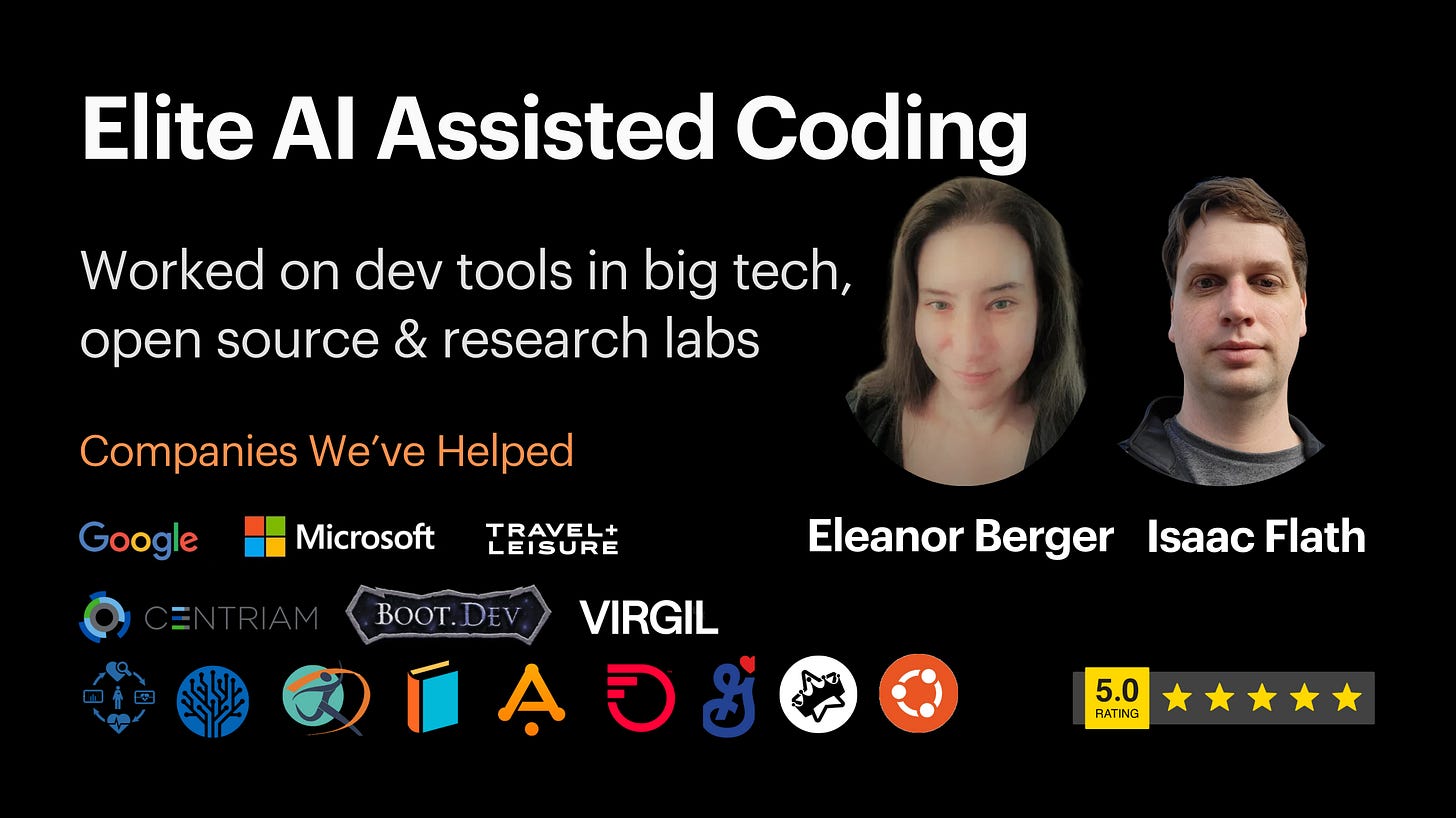Course: Elite AI Assisted Coding
Course Overview
Duration: 3 weeks, 12 live sessions
Format: Cohort-based course
Goal: Transform generic AI assistants into personalized coding partners that understand your codebase, patterns, and needs
Learning Structure
Each part (week) of the course includes:
2 live lessons
Office hours session (Q&A and discussion)
Live practice session
Homework assignment (with both begginner-friendly and stretch exercises)
Pre-reads and lesson materials
Deep-dive collections (optional) for exploring topics in depth
In addition, learning continues with:
Questions and discussions in the course Discord server
Guest lectures
Student exchange and collaboration
Core Value Proposition
Stop wasting time with generic AI suggestions. Learn to create a personalized AI coding partner that actually understands YOUR specific context and requirements, regardless of which AI tools you use.
Instructors
Eleanor Berger: Engineering and AI leader with experience in DevOps/SRE/Cloud, Applied AI, and Engineering Leadership.
Isaac Flath: Dev efficiency expert with experience at big tech, open source, and advising companies.
Companies We've Helped
SpecStory
Travel and Leisure
Cable & Wireless Communications
GitHub
Microsoft
Google
Canonical
Answer AI
and many more …
Companies Our Students Are From
Amazon (AWS)
Microsoft
Google
X
Shopify
Cisco
LinkedIn
Red Hat
DocuSign
Qualcomm
Monster
Booz Allen Hamilton
TrustLayer
and many more …
Weekly Session Breakdown
Week 1: Foundation & Personalization
Introduction to AI-Assisted Software Development
Course orientaion.
Tools and human in the loop - Claude, Copilot, Cursor, Codex … and you.
Recognize capabilities, limits, pitfalls, safety, and coding pattern basics.
Start with any modern IDE, terminal, or browser-based agent with near-zero setup.
Context Engineering & Frictionless Setup
Context stack: rules, docs, tools.
MCP in practice: context and action.
Supporting docs: importing key library/framework docs; updates; combining static imports with MCP.
Determinism & validation: smoke prompts, golden answers, scripted checks.
Week 2: Interactive Development & Collaboration
Interactive Agents & Spec‑First Planning
Spec‑first flow: requirements → tasks → constraints → evaluation.
Mastering modern coding agents (in IDE and terminal).
De‑risking scope: narrow diffs, feature flags, rollback plans.
Custom MCPs, workflows, commands, and subagents.
AI Code Review, PR Orchestration & Security
Coding agent security: private data + untrusted context ⇒ risk.
Approvals & execution modes and environments: fine-grained permissions, sandboxing, execution modes.
Auditability: structured logs and git history.
AI-powered DevOps: PRs, project management, deployment, observability.
Week 3: Async Agents, CI/CD & Advanced Techniques
Async/Background Agents & Dynamic Context
Background agent architectures: SaaS, GitHub Actions, scheduled tasks, job runners.
Effective delegation: specs and environments for end-to-end AI execution.
Automating software projects with continuous AI.
Parallelization, Measuring Efficacy, & Continuous Improvement
Accelerating efficiency with parallel agents and workflows.
Measuring and reasoning about efficiency and quality in AI-powered software development.
Mining projects for evidence-based decision making and continuous improvement.
Key Learning Outcomes
Technical Skills
Universal AI Setup System: Build context systems that work across ALL major AI tools (no vendor lock-in)
Automated Context Evolution: Automate context updates based on actual coding patterns
Pattern Mining & Analysis: Turn every AI mistake into a learning opportunity
MCP Server Development: Create practical automation tools for daily use
Practical Applications
Create and maintain context-independent rules across all major AI coding tools
Efficiently manage and sync context for different formats (Amp, Cursor, Copilot, Windsurf, Claude Code)
Analyze conversation history to identify and fix AI pattern failures
Build real integrations that drastically enhance workflow
Workflows
Plan and task-based agentic processes
Targeted human augmentation approaches
Matching tasks to optimal AI assistance methods
Enterprise deployment strategies and processes
Enterprise Integration
Implementing AI coding tools in enterprise settings
Security and compliance considerations
Team adoption strategies
Scaling personalized context across organizations
Integration with existing development workflows
Target Audience
Developers who:
Use AI coding assistants but feel limited by generic suggestions
Want to maximize productivity with personalized AI tools
Need a vendor-agnostic approach to AI coding assistance
Seek practical, production-ready solutions over theoretical concepts
Know AI should be better, but doesn't see how to get there
Course Philosophy
Focus on real-world applications
Vendor-agnostic approach ensures long-term value
Continuous improvement through automated pattern analysis
Practical tools you'll use daily in production environments

